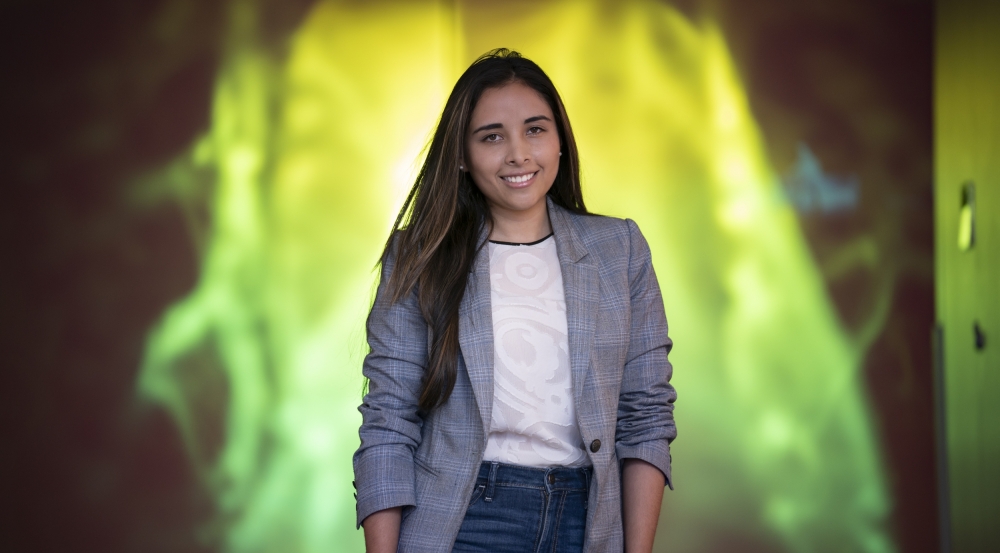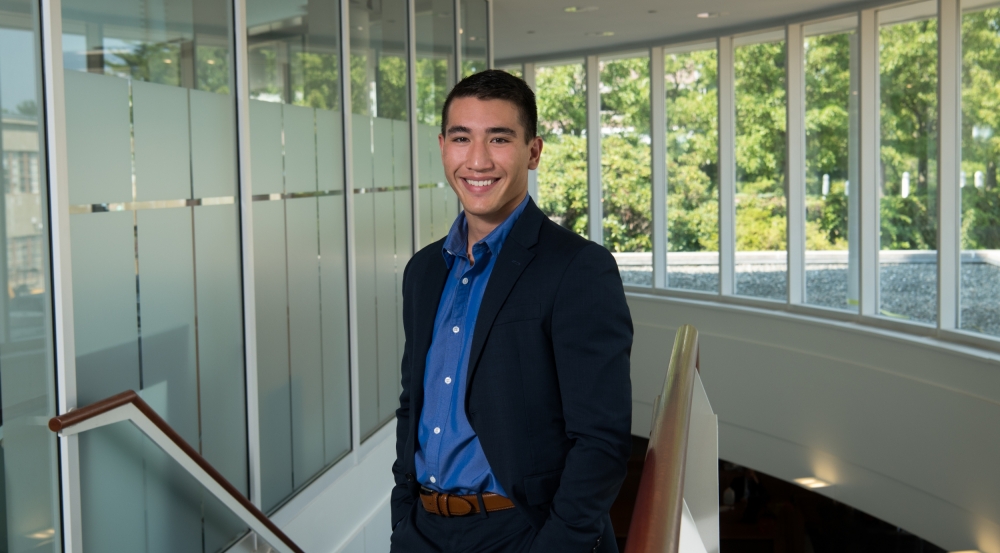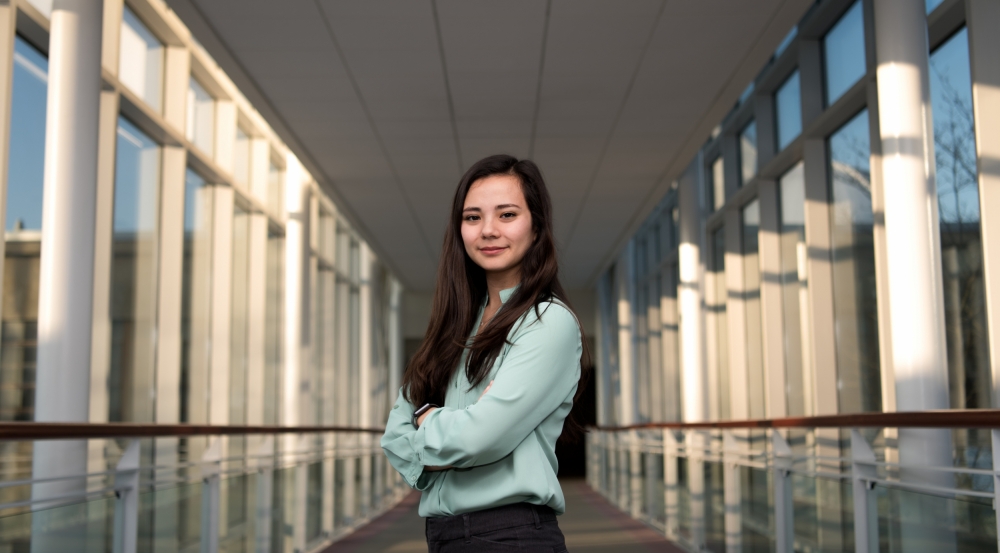"Future leaders" in aerospace complete summer research
More than 200 students were welcomed to Lincoln Laboratory for the summer research program this year. Beyond sharing an experience conducting R&D for national security applications, four of these students had something more specific in common: each were named to Aviation Week Network's 20 Twenties list in 2018.
The award, cosponsored by the American Institute of Aeronautics and Astronautics, recognizes the nation's twenty most promising future leaders in the aerospace industry. The four students, Estefania Bohorquez, Jared Ham, Matthew Alder, and Alexa Aguilar, each made important contributions to their groups' work this summer.
Estefania Bohorquez

When asked why she chose to spend her summer at the Laboratory, creativity is what comes to Estefania Bohorquez's mind. "What I find exciting is being able to use my unique background as a tool to approach problems creatively from a different perspective," said Bohorquez, who is pursuing her master's degree in mechanical engineering at the University of Florida.
Bohorquez has studied micromechanics at the German Aerospace Center, researched power generation at Siemens, and even did some structural "imagineering" for the Walt Disney Company. She took on something new with the Laboratory's Structural and Thermal-Fluids Engineering Group.
Bohorquez worked on a lightweight heat exchanger for small electronics. The exchanger is used to transfer heat generated by the electronic device to a flowing fluid to cool the device. As part of her role, she designed and tested prototype parts for the heat exchanger, getting a crash course in 3D printers and laser cutting tools at the Technology Office Innovation Laboratory along the way.
"The most interesting part was learning more about phase Doppler anemometry for particle analysis and nozzle design," Bohorquez said. Phase Doppler anemometry is used to analyze the flow of particles as they move through the heat exchanger and is conducted by pointing laser light under the particle spray nozzle and processing the scattering pattern caused by the particles. "To do this, I had to learn about laser alignment and signal processing," she said.
"Estefania was a pleasure to work with this summer," her Laboratory mentor William Flaherty said. "She consistently brought a positive attitude and excitement to her work."
As for what's next, Bohorquez received both a Fulbright Fellowship and a National Science Foundation Graduate Research Fellowship. She plans to continue research that allows her to merge her broad interests within engineering mechanics.
Jared Ham

The project that drew Jared Ham to the Laboratory was one that he saw featured on "60 Minutes" last year: the autonomous, formation-flying, micro-drone called Perdix. "The things that excite me most are the advancements being made in unmanned vehicles for use on land, in water, or in the air," said Ham, who is studying mechanical engineering and computer science at Colorado State University.
In line with his passion, Ham spent the summer trying out new concepts for high-speed unmanned aerial vehicles. Part of his job involved looking into how commercial electric ducted fan (EDF) systems could be used to propel small aircraft from a tube at high speeds. Little work has been done on this concept in the past, so Ham came up with a wind-tunnel testing plan that will provide engineers with accurate EDF thrust and power consumption predictions for designing a system in the future.
Ham has two years left in his undergraduate degree programs, time he'll spend deciding whether to go forward with a master's degree or enter straight into the workforce after graduation. He knows for certain that he wants a career in the aerospace industry.
Matthew Asper

Matthew Asper first became interested in aerospace as a high school student — he wanted to be an astronaut. Yet in learning more about the profession, he saw there was a world to explore within the actual materials and structures that enable spacecraft to carry humans to orbit. "I found that there is so much work to be done with the increase in improved materials and manufacturing capabilities," Asper said.
At the Laboratory, Asper has been experimenting with both manufacturing and materials. He investigated how to use additive manufacturing to produce a metal matrix composite, a material that consists of a metal reinforced with a nonmetal compound that, among several advantages, can offer very high strength and temperature resistance. This work required him to use advanced tools such as a scanning electron microscope and a particle analyzer.
"Not only will operating these tools aid in the characterization of composite powders that we are studying, but it'll also give me the experience necessary to excel in my career following my time here at the lab," Asper said.
Asper is entering his senior year at the University of Virginia to earn his bachelor's degree in aerospace engineering with a minor in materials science engineering. He'll be participating in a NASA-sponsored aircraft design competition as part his senior thesis.
In the future, he sees himself continuing to explore the materials and structures side of aerospace engineering in a doctoral program. He hopes for another research opportunity at the Laboratory. "I'm tremendously grateful for the resources available to me at the Laboratory, such as the staff, equipment, and even fellow interns who have taught me many different ways to approach challenges."
Alexa Aguilar

Alexa Aguilar is at the Laboratory for a second summer in a row. A participant in the GEM Fellowship Program, which matches top graduate students from underrepresented communities to internships in the nation's leading laboratories, she's continuing to work with the Advanced Sensors and Techniques Group.
Aguilar worked on getting a new program started within the group that stemmed from a concept she and a team of interns developed during the Laboratory's annual summer intern idea challenge. The idea is to use commodity Wi-Fi components, instead of custom radar hardware, to enable first responders to detect and localize victims in need of rescue.
"I really liked the research topic and being a part of the program start-up process," Aguilar said. "This is also my first experience with localization, so taking it from theory to implementation has also been both challenging and exciting."
This fall, Aguilar will be making headway in her second year in the MIT Department of Aeronautics and Astronautics (AeroAstro) master's program.
George Pantazis, one of Aguilar's mentors at the Laboratory, praised Aguilar's efforts. "Edison once said, 'Genius is one percent inspiration and 99 percent perspiration.' Alexa is one of the rare few who has 100 percent of both to offer. During her time as an intern she demonstrated a steadfast commitment, diligence, independence of thought, and ingenuity in everything she worked on."